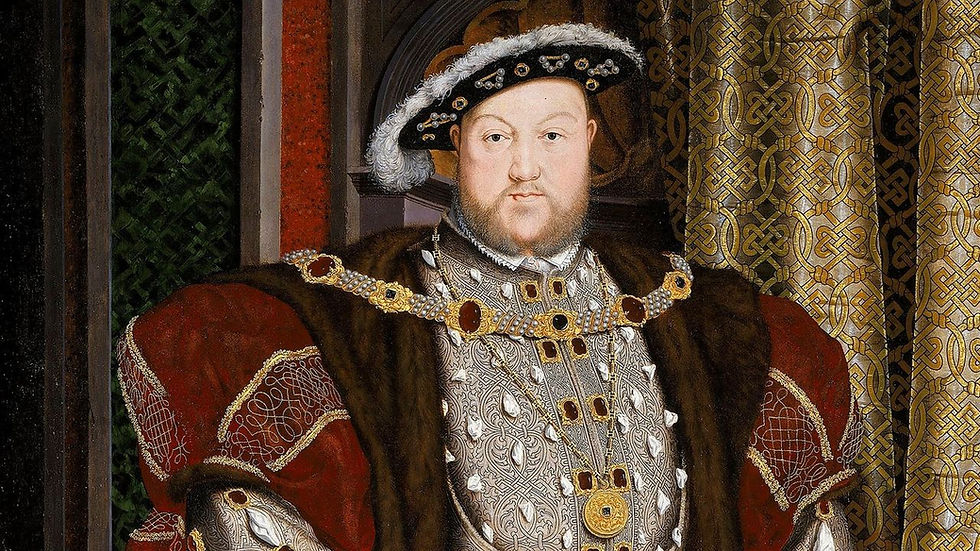What We Can Learn From Henry VIII: Leadership Lessons From the Tudor Court
- verity858
- Jun 21
- 4 min read
Updated: Jul 20
When you hear the name Henry VIII, what comes to mind first? The six wives? The break from Rome? Or maybe the infamous portraits of a broad, brooding monarch in fur and velvet? History remembers Henry as a tyrant, a religious disruptor, and a king obsessed with securing his legacy — often through questionable means. But while his reign was marred by ego and excess, it also offers powerful lessons for today’s leaders, especially those navigating high-stakes decisions, shifting allegiances, and the desire to make their mark.
So what can a 16th-century king possibly teach us about leadership in the modern workplace?

Who was Henry VIII?
Born in 1491, Henry VIII became King of England in 1509 at the age of 17. Handsome, charming, and highly educated, he wasn’t originally destined for the throne — that was his older brother Arthur’s role — but Arthur’s early death thrust Henry into kingship and the political spotlight. At first, he was celebrated as a golden boy: athletic, musical, devout. His early reign was marked by jousts, pageantry, and hopes of stability after the Wars of the Roses.
But behind the glamour, Henry’s reign would go on to be one of the most turbulent in English history. He broke from the Roman Catholic Church, created the Church of England, executed two of his wives, and left behind a fractured royal lineage that led to years of instability after his death. And yet, his legacy remains one of the most studied and discussed to this day.
Where he excelled
It might be tempting to write Henry off as a textbook example of terrible leadership, but doing so ignores the strategic nous he occasionally displayed.
1. Bold vision and decisiveness
Henry’s decision to break from Rome wasn’t just about his marital woes — it was a seismic political and religious shift. It took immense conviction to override centuries of tradition, face excommunication, and create an entirely new religious structure. Whether or not you agree with the motive, the scale of the vision was undeniable.
2. Strategic control of messaging
Henry was one of the first monarchs to fully grasp the power of propaganda. Through paintings, public declarations, and selective storytelling, he shaped how he wanted to be seen: as God’s appointed ruler, a wise judge, and a manly warrior king. It was brand building, Tudor-style.
3. Institutional transformation
His dissolution of the monasteries redistributed wealth and land on a massive scale, allowing for greater centralised power and the rise of a new class of nobility. This act reshaped the English economy and class system — not unlike a CEO restructuring an entire organisation to match their strategic vision.
Where it went wrong
Of course, Henry is just as famous for the wreckage he left in his wake — much of which came down to a few fatal leadership flaws.
1. Fear-based leadership
Henry’s court was a place of constant anxiety. Trusted advisors like Thomas More and Thomas Cromwell rose quickly, only to be executed when they no longer served his aims. Dissent was not tolerated. Loyalty was rarely rewarded. It created a culture of fear and silence — the opposite of psychological safety.
2. Ego over empathy
He listened less as time went on, surrounding himself with flatterers and removing those who challenged him. His inability to admit mistakes — or take advice — isolated him and narrowed his decision-making.
3. Obsessed with legacy, blind to impact
Henry’s quest for a male heir defined his personal and political life. In doing so, he undermined capable leaders (like his daughter Elizabeth, who would go on to be one of England’s greatest monarchs), destabilised his marriages, and left the country divided in his wake. His legacy became about control, not continuity.
Leadership lessons for today
So what can we take from all this?
1. Bold moves must be backed by purpose
Disrupting the norm can be powerful, but only when it’s in service of a greater goal. Henry’s break from Rome was revolutionary, but his reasons were personal. As modern leaders, we must ask: Is this move in service of my ego — or the mission?
2. Power without trust is a fragile thing
Fear may win compliance, but it doesn’t breed innovation or loyalty. Henry’s reign teaches us that authority without empathy leads to isolation — and eventually downfall. True influence comes from credibility, not control.
3. Legacy is built through people, not just policy
Henry wanted to be remembered, but the strength of his legacy came not from his proclamations, but from the daughter he once dismissed. Today’s leaders must remember: your impact lives on in the people you empower, not the systems you control.
Final thought
Henry VIII was no model leader — but he was a memorable one. His reign reminds us that leadership is never just about results; it’s about how those results are achieved, and who gets left behind. In a world that still rewards boldness and visibility, his story is a cautionary tale: vision without values can cost you everything.
So what do you think — was Henry a visionary king, or a leadership warning in royal robes? I’d love to hear your thoughts in the comments.
And if you’re on your own leadership journey, I’d love to support you. Learn more about Leadership Unlocked — a programme for modern leaders who want to grow with clarity, confidence, and credibility.




Comments